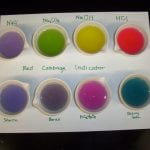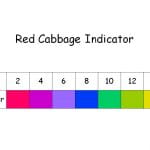DESCRIPTION:
Many anthocyanins change color depending on the pH of the solution they are in. This class of compounds is represented in red cabbage extract which can be used as a natural pH indicator.
TOPICS COVERED:
– acids and bases
– indicators
– color change
– chemical change
MATERIALS NEEDED:
– red cabbage
– knife
– cutting board
– 600 mL beaker
– 250 mL beaker
– hot plate
– cheesecloth
– funnel
– water
– small evaporating dishes
– solutions of varying pH (NaCl, Na2CO3, NaOH, HCl, borax, HC2H3O2, baking soda)
PROCEDURE:
1. Fill the 250mL beaker full of water and heat
2. Chop up some cabbage into small pieces, they don’t have to be fine or even of uniform size, and place into the 600mL beaker
3. Add the hot water to the large beaker, and allow to soak for a few minutes
4. Filter the liquid into a bottle to keep, the cabbage can be trashed
5. Place some of each solution into an evaporating dish
6. Add some of the indicator you made to each solution and observe
ADDITIONAL COMMENTS:
Cabbage doesn’t have the most pleasant smell. The indicator can stain, so gloves and aprons are advised.
SAFETY:
The beaker on the hot plate will be very hot. Safety goggles should be worn at all times.
REFERENCES:
Shakhashiri, B.Z. Chemical Demonstrations; University of Wisconsin Press: Madison, 1989; Vol. 3, pp 50 – 57.
Meerman, Ruben. “Cool Chemistry – DIY pH Indicator.” Posted 9 Nov 2007. Accessed 17 June 2010. http://www.abc.net.au/science/surfingscientist/pdf/lesson_plan16.pdf
This lesson plan‘s topic is acids and bases. This 5E inquiry style lesson has students explore different concentrations of solutions with pH meters to determine how the pH scale works. Students then learn how to calculate pH and pOH before constructing a colored pH scale for Red Cabbage Indicator.

